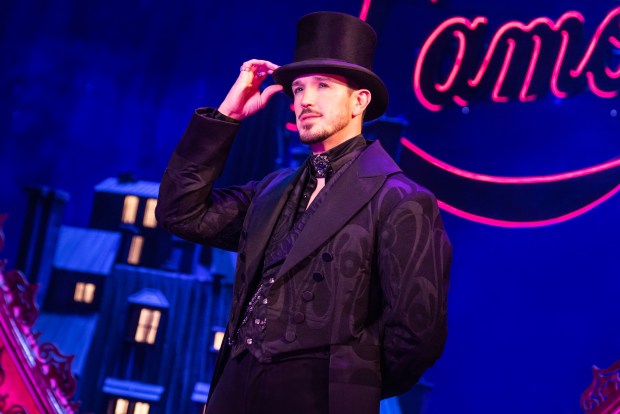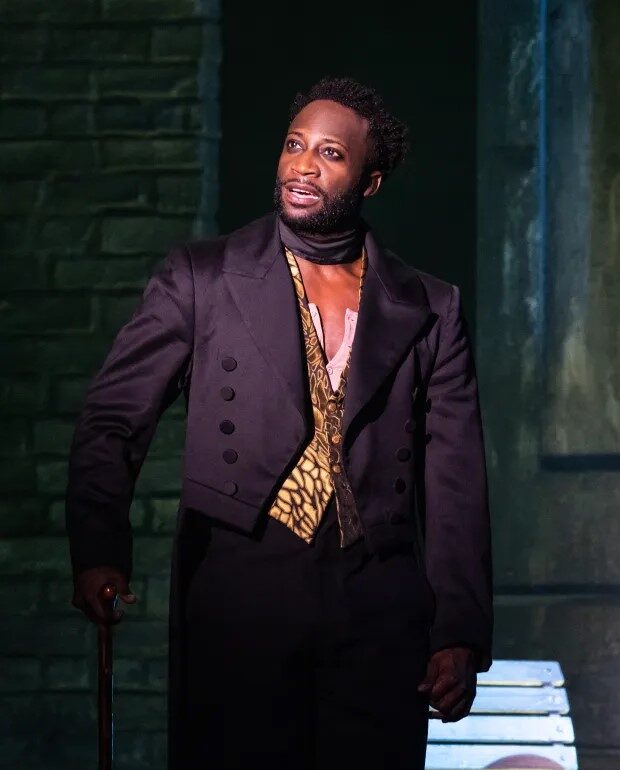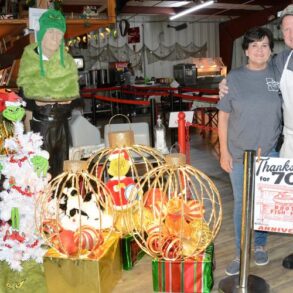Since some people still do dress to impress in the Bushnell lobby, what does the thoughtful theatergoer wear to see “Moulin Rouge! The Musical”? In the case of this style-conscientious critic, it was a new bowler hat I’d just gotten for my birthday, a wool vest, black jeans, green Doc Martens boots and a Toad’s Place T-shirt. That attire covers all the “Moulin Rouge!” bases: trad, rock and roll, romantic, comfortable and timelessly fashionable. The show is a sumptuous rock and roll cabaret, a steampunk serenade, a love story set amid a lingerie fashion show. Dress appropriately.
Tour of ‘Moulin Rouge’ will can-can to modern pop hits at The Bushnell
Above all else, “Moulin Rouge! The Musical” is just a fun night out on the town. That’s what it’s about, and that’s what it inspires.
The stage musical adaptation of the over-the-top 2001 Baz Luhrmann film about love, art and deception in fin de siècle Paris is at The Bushnell through Dec. 3. That’s a longer than usual run for a show on The Bushnell’s Broadway series. This means you can find time to visit “Moulin Rouge!” more than once if you feel you’ve missed one of the multitudes of sly winks or not-so-subtle outthrust derrieres, and especially if you’ve lost count of the number of familiar pop melodies melding into the show’s quasi-operatic style.

Courtesy Matthew Murphy/MurphyMade
Nick Rashad Burroughs as the artist Toulouse-Lautrec in the national tour of “Moulin Rouge! The Musical” at The Bushnell. (Courtesy Matthew Murphy/MurphyMade)
Calling “Moulin Rouge” a jukebox musical sells it very short. It doesn’t perform these internationally recognized hit tunes as you usually hear them, and it rarely does gets through a single song without blending it deliriously with some other number. “Diamond’s Are a Girl’s Best Friend” bleeds into “Material Girl” and “Tainted Love” gets mashed into “Bad Romance.”
Something like 70 songs are in the “Moulin Rouge!” mix, some done in their near-entirety like Nat “King” Cole’s “Nature Boy” and others referenced only fleetingly in medleys. One short line from David Bowie’s “Heroes” becomes a recurring motif. Some directly comment on the plot, as when The Police’s “Roxanne” is used to warn the show’s heroine Satine not to continue being a courtesan.
“Moulin Rouge!” was a movie that was always begging to be a live theater show. The film even begins with the image of an orchestra tuning up. It may be best remembered for its dramatic reworkings of tunes by Elton John, The Police, The Rolling Stones and numerous ‘90s pop divas, the original “Moulin Rouge!” also honored American musical theater history with “Diamonds Are a Girl’s Best Friend” (from the 1949 Broadway musical “Gentlemen Prefer Blondes”) and an interpolation of “The Sound of Music.” It also evokes grand opera.
Of course, the film also celebrated old Hollywood movie musicals, and stretched the boundaries of what a movie musical could look like. The stage show has its work cut out for it attempting to replicate Luhrmann’s creativity and unpredictability. Fortunately, the original Broadway production, and now this tour, were able to get a director who’s basically Luhrmann’s live theater counterpart. Alex Timbers has been known for his endlessly inventive stage work since he was an undergraduate at Yale in the late 1990s. His New York theater resume includes “Beetlejuice,” “Peter and the Starcatcher,” “Bloody Bloody Andrew Jackson” and the current “Gutenberg! The Musical.”
Watching the movie today, what once looked dreamy and abstract now looks cartoonish due to its once cutting-edge special effects now looking rather primitive. A live stage show doesn’t have that problem. “Moulin Rouge! The Musical” is a technical marvel on a live theater scale, but wisely doesn’t try to mimic the movie’s can-can close-ups, technicolor washes and snappy edits. What “Moulin Rouge! The Musical” can and does is concentrate on the movie’s exhaustingly fast pace and its mad musical medleys.
Like the movie, the musical sets up this singularly synthesized culture-cruising style so clearly and efficiently in its opening moments that it’s easy to acclimate yourself to it. The opening number in the Moulin Rouge nightclub (where nearly the entire show is set, its different rooms and stages evoked with dozens of different backdrops) with Parisian chorus members cavorting through “Lady Marmalade” before lurching into “Burning Down the House” sets the mood completely before any key aspect of the plot is divulged.
It’s a love story. The songs are all love songs. The lusty though not lurid dances express sheer unadulterated passion. “Moulin Rouge!”’s decades-spanning set list may seem all over the place, but it’s actually very focused and single-minded.
The show is giddy without being silly. It’s funny, but not a parody. It’s melodramatic, not tragic. It’s sexy without being lewd. Singing and dancing in this cabaret netherworld takes special entertainment skills. As good as some of the lead players are, it’s the hard-working ensemble of backing singers and dancers who really set the tone and pace. They change costumes with lightning speed, with some of the transformations happening onstage as if they were magic tricks. They switch from imposing townsfolk to booty-shaking can-can dancers.
With so many tonal shifts, and such exhausting changes, some routines land far better than others. Some of the singing is exceptional, some is more distinctive than it is well done, and some falls flat. Unfortunately, Gabrielle Clinton as the heroine Satine is in the “sturdy but doesn’t soar” category. Satine’s smitten young lover Christian (whose occupation is songwriter here, rather than poet as in the movie) is played by Christian Douglas, who belts with an over-the-top, arch, ironic yet undoubtedly romantic passion. Douglas captures the odd mix of attitudes that defines “Moulin Rouge!” The show’s second act is largely a showcase for the Christian character, who can’t stop declaring his love for Satine. She doesn’t have much to sing back to him, perhaps because there are not many established pop hits about lying to the love of your life because you’re suffering from consumption.
Some of the other lead players, like the boyish booming-voiced Douglas or Andrew Brewer as the snide Duke of Monroth (a character who’s more nuanced in the film but is now a top-rank evil cartoon villain) fit the “Moulin Rouge!” mold beautifully. As the ringleader of the “Moulin Rouge” melange, Broadway veteran Robert Petkoff is completely unrecognizable from his last time on the Bushnell stage, when he played the depressive closeted father Bruce in the musical “Fun Home.” He is grand and corny but also nicely restrained, since you don’t want your master of ceremonies to be a wild card. As the bohemian artist Toulouse-Lautrec, Nick Rashad Burroughs goes in a different direction, avoiding cafe society stereotypes and bringing a world-weary, living-on-the-edge realism to the role.

Matthew Murphy/MurphyMade
Andrew Brewer as The evil Duke of Monroth in “Moulin Rouge” at The Bushnell.
As sharply formed as these characters are, “Moulin Rouge!” is not centered on any one performance. The show is defined by its wild style and its ripped-from-the-pop-charts dialogue. The stage version eschews the fantasy technical effects of the movie: There is no dancing pixie or cascade of top hats, and nobody flies into the stratosphere. “Moulin Rouge! The Musical” is about about teeming humanity, about a stage full of peppy people in colorful skirts, dour top hats and snappy vests with pocket watch chains leaping about like the world is ending and they’re in love.
This show is really about its impeccably energetic and erotic chorus, the bodies that crowd the main characters and personify the difficulties the heroes face: the rigors of non-stop partying, the disapproval of high society, the stress of not knowing what the next day will bring. “Moulin Rouge!” dances like there was no tomorrow over 120 years ago.
“Moulin Rouge” runs through Dec. 3 at The Bushnell, 166 Capitol Ave., Hartford. Remaining performances are Nov. 25 at 2 and 8 p.m., Nov. 26 at 1 and 6:30 p.m., Nov. 28-30 at 7:30 p.m., Dec. 1 at 8 p.m., Dec. 2 at 2 and 8 p.m. and Dec. 3 at 1 and 6:30 p.m. $43-$168. bushnell.org.
This post was originally published on this site be sure to check out more of their content.







